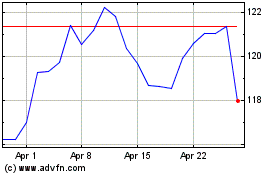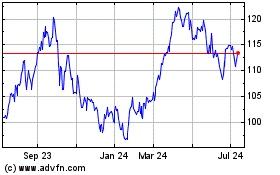By Selina Williams
Oil companies that piled into Iraqi Kurdistan after Saddam
Hussein's ouster are running into trouble, unraveling the region's
promise as source of easy-to-drill oil and threatening Iraq's
production surge.
Chevron Corp. and Exxon Mobil Corp. have been exploring for oil
in Kurdistan since 2012, but have yet to develop anything. Two of
the region's leading producers are stumbling: Genel Energy PLC in
February said its largest oil field had only half the oil it
thought, while Gulf Keystone Petroleum Ltd. said it is running out
of money to pay its debts because of low oil prices and the lack of
regular payments from the Kurdistan Regional Government for the oil
it has pumped.
The regional government's Ministry of Natural Resources declined
to comment.
Any slowdown in Kurdistan's oil production could affect energy
markets because previous drilling success there helped Iraqi output
climb by almost 20% in 2015 to 3.99 million barrels a day -- about
4% of global output. This mounting production contributed to a
global glut and helped sink prices to $27 a barrel in January, the
lowest level in 12 years.
Kurdistan, a region about the size of Switzerland, was once
believed to hold as much petroleum as the North Sea. It has been a
magnet for Western investment in the past decade -- a rarity in the
Middle East, where most international oil companies are either
banned from exploring for and pumping oil or are forced to work
under stingy contracts.
The regional government estimates Kurdistan has at least 45
billion barrels of oil to be found. The energy industry has long
referred to these resources as "easy oil": onshore and pumpable
with traditional methods, like fields in Saudi Arabia and Kuwait,
where production can cost as little as $2 a barrel.
That is far cheaper than more typical recent oil-and-gas
developments, many of which are deep beneath the sea or embedded in
shale rock, requiring costly drilling infrastructure and
techniques.
But these assumptions about Kurdistan oil are being questioned
by some companies reviewing the geology -- and not liking what they
are finding.
"Kurdistan is not easy oil," said one oil executive whose
company has worked in the region. More of the oil requires
additional techniques, such as horizontal drilling, than previously
thought, the executive said. Much of it has turned out to be a type
of crude described as heavy -- harder to pump and refine and less
valuable on international markets.
That crude can also contain toxic and flammable hydrogen sulfide
gas that requires additional investment to strip out, said Jessica
Brewer, from energy consultancy Wood Mackenzie.
"There's obviously large volumes of oil in place," she said.
"It's how much can be recovered economically that is
important."
While oil production in Kurdistan grew to around 430,000 barrels
a day in 2015 from virtually nothing a decade earlier, it is still
well below earlier Kurdish government plans to be pumping one
million barrels a day by now.
Kurdistan became a magnet for Western investment after 2006,
when the regional government unveiled attractive terms for
international oil companies that weren't available in southern
Iraq.
The region had been largely ignored under Saddam Hussein's rule.
But in 2011, former BP PLC chief Tony Hayward hailed Kurdistan as
one of the industry's last great frontiers.
Mr. Hayward engineered a $2.1 billion deal that year to take
over Genel, the largest foreign oil producer in Kurdistan, and said
the region's prospects "have never been brighter." Giants like
Exxon, Chevron and France's Total SA followed, along with many
other oil companies.
Genel's prize field Taq Taq is currently producing only 80,000
barrels a day, around half of last year's peak output. By 2018,
output is expected to fall to as low as 50,000 barrels a day.
Mr. Hayward said the Taq Taq downgrade was a "major setback,"
but noted the company still had some of the lowest-cost producing
assets in the world.
Genel is to hold its annual general meeting on Wednesday. The
company declined to comment further.
Genel's announcement followed a steady stream of bad news for
other oil companies' fields there.
In January 2015, U.K.-listed Afren PLC said its Barda Rash field
essentially held no reserves. In March, Irish explorer Petroceltic
International PLC and the U.S.'s Hess Corp. pulled out of the
Dinarta license, citing disappointing well results. In November,
Chevron relinquished its Rovi block without explanation after
drilling exploration wells.
Exxon said its exploration operations continue in line with its
contractual obligations. Afren, Petroceltic and Hess declined to
comment.
Kurdistan's producers were already in trouble before problems
with the geology emerged. In 2014, Islamic State militants advanced
on Kurdistan's borders coming within a few hours' drive of some of
the oil fields. The Kurds' expensive fight against Islamic State
has yielded some important victories in recent months, with the
militant group on the defensive after intensified airstrikes by a
U.S.-led coalition, but the threat remains.
Kurdish oil exports were temporarily halted in February
following an attack on a pipeline through Turkey.
The regional government and Baghdad authorities argued over whom
oil revenues belonged to, prompting the central government to
withhold funding from the Kurds. In turn, the regional government
fell behind by over a billion dollars in payments to international
oil companies. The KRG is far from clearing the arrears, but has
begun paying some of it back.
"There are geopolitical challenges for the region -- it's not
for everybody," said Gulf Keystone Chief Executive Jón Ferrier.
Gulf Keystone is weighed down by debt incurred when oil prices
were high and relies on the Kurdish government's payments to meet
its own repayments to bondholders. The company is facing crunchtime
next year when $575 million is due and is looking to restructure
its debt.
However, Mr. Ferrier said that the Shaikan field has enough oil
to keep producing and generating revenue for at least 40 years.
(END) Dow Jones Newswires
April 26, 2016 18:23 ET (22:23 GMT)
Copyright (c) 2016 Dow Jones & Company, Inc.
Exxon Mobil (NYSE:XOM)
Historical Stock Chart
From Mar 2024 to Apr 2024

Exxon Mobil (NYSE:XOM)
Historical Stock Chart
From Apr 2023 to Apr 2024
